Urban infill maximizes the use of vacant or underutilized land within existing city areas, promoting sustainable growth and reducing urban sprawl. This approach enhances infrastructure efficiency, supports public transit, and revitalizes communities by integrating new developments with existing neighborhoods. Discover how urban infill can transform your city and shape its future by reading the rest of the article.
Table of Comparison
| Aspect | Urban Infill | Urban Sprawl |
|---|---|---|
| Land Use Efficiency | High - utilizes vacant and underused urban land | Low - expands into undeveloped greenfield areas |
| Environmental Impact | Reduced habitat disruption and lower carbon footprint | Increased habitat loss and higher greenhouse gas emissions |
| Transportation | Supports public transit, walking, and cycling | Dependence on private vehicles, increased traffic congestion |
| Infrastructure Costs | Lower due to use of existing facilities | Higher from extending roads, utilities, and services |
| Community Impact | Promotes vibrant, mixed-use neighborhoods | Leads to isolated, car-dependent communities |
| Resource Conservation | Preserves open space and natural resources | Consumes more water, energy, and land resources |
Understanding Urban Infill: Definition and Key Features
Urban infill refers to the process of developing vacant or underused land within existing urban areas to maximize land utilization and reduce the need for outward expansion. Key features include higher density development, improved infrastructure efficiency, and enhanced walkability, which contribute to sustainable urban growth and reduced environmental impact. This approach contrasts with urban sprawl, which involves low-density, outward expansion that often results in increased traffic congestion, loss of green space, and greater infrastructure costs.
Urban Sprawl Explained: Causes and Characteristics
Urban sprawl refers to the uncontrolled expansion of urban areas into peripheral rural lands, driven by factors such as population growth, increased car dependency, and housing demand. This phenomenon is characterized by low-density development, single-use zoning, and extensive land consumption, which often leads to increased traffic congestion, environmental degradation, and loss of agricultural land. Key causes include suburbanization trends, limited urban planning policies, and economic incentives favoring large-scale residential subdivisions over compact city development.
Land Use Efficiency: Infill vs. Sprawl
Urban infill significantly enhances land use efficiency by maximizing development within existing urban boundaries, reducing the need to consume undeveloped land and preserving natural habitats. In contrast, urban sprawl spreads development across extensive areas, leading to inefficient land use, increased infrastructure costs, and greater environmental impact. Efficient infill strategies promote sustainable growth by optimizing existing resources and minimizing carbon footprints associated with extended transportation networks.
Environmental Impacts: Comparing Urban Infill and Sprawl
Urban infill promotes sustainable development by utilizing existing infrastructure and reducing the need for new land consumption, which minimizes habitat destruction and lowers greenhouse gas emissions. In contrast, urban sprawl leads to increased vehicle dependency, greater energy consumption, and significant loss of agricultural and natural lands, intensifying pollution and biodiversity decline. Studies show compact development patterns associated with urban infill contribute to improved air quality and reduced carbon footprint compared to sprawling suburban expansion.
Transportation and Connectivity in Infill and Sprawl Developments
Urban infill promotes efficient transportation by enhancing connectivity through mixed-use developments and improved public transit access, reducing reliance on private vehicles and lowering traffic congestion. In contrast, urban sprawl tends to increase car dependency due to dispersed land use and limited public transit options, resulting in longer commute times and higher greenhouse gas emissions. Optimizing infill development supports sustainable mobility by prioritizing walkability, bike lanes, and integrated transit networks.
Social and Economic Effects of Urban Infill vs. Sprawl
Urban infill enhances social cohesion by revitalizing existing neighborhoods, increasing walkability, and supporting diverse community interactions, while reducing infrastructure costs and promoting efficient land use. In contrast, urban sprawl often leads to social fragmentation, longer commutes, and greater dependency on automobiles, resulting in higher public expenditures for road maintenance, utilities, and environmental degradation. Economically, urban infill stimulates local businesses and raises property values through increased density, whereas sprawl can dilute economic activity across wider areas, straining municipal budgets and limiting access to services.
Infrastructure Costs and Urban Growth Patterns
Urban infill promotes efficient use of existing infrastructure, reducing the need for costly expansions by focusing development within established urban areas. In contrast, urban sprawl leads to higher infrastructure costs due to extending roads, utilities, and public services over larger, less dense areas. Urban growth patterns in infill prioritize sustainability and density, while sprawl encourages decentralized expansion, increasing maintenance expenses and environmental impact.
Housing Diversity and Affordability: Infill vs. Sprawl
Urban infill promotes housing diversity by integrating mixed-use developments and varied housing types within existing neighborhoods, enhancing affordability through efficient land use and reduced infrastructure costs. In contrast, urban sprawl primarily consists of single-family homes in low-density areas, leading to higher housing prices and limited affordable options due to increased reliance on automobile transportation and extended utility infrastructure. Studies show infill development can reduce per-unit housing costs by up to 20%, supporting more inclusive and sustainable communities.
Urban Policy Strategies: Promoting Infill or Controlling Sprawl
Urban policy strategies promoting urban infill prioritize efficient land use by encouraging development within existing urban areas, reducing infrastructure costs and preserving green spaces. These policies often include zoning reforms, incentives for redevelopment, and investments in public transit to support higher density living. In contrast, controlling urban sprawl involves implementing growth boundaries, limiting peripheral expansion, and enforcing stricter land-use regulations to curb suburban spread and protect natural habitats.
Future Trends: Sustainable Urban Development Solutions
Urban infill focuses on optimizing underused urban spaces to create compact, walkable neighborhoods that reduce reliance on cars and lower carbon emissions, enhancing overall sustainability. In contrast, urban sprawl often leads to increased vehicle use, habitat fragmentation, and greater infrastructure costs, challenging long-term environmental goals. Future trends emphasize smart growth strategies, integrating green infrastructure and mixed-use developments to foster resilient communities and mitigate the negative impacts of sprawling development.
Urban infill Infographic

 libterm.com
libterm.com